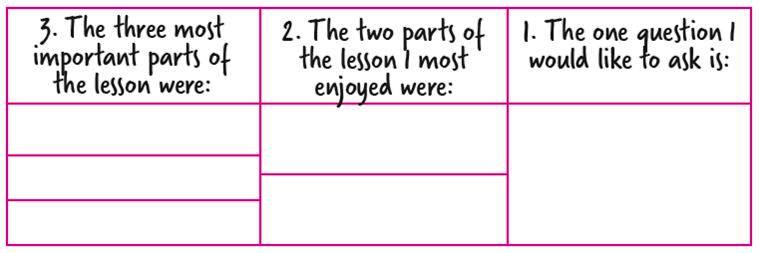1. Read, Reflect, Respond
One of the central features of AfL is moving towards comment-only marking as a means to increasing learning gains; this can be written or oral comments. Recognise that the quality of comments is critical, as the feedback needs to be specific, formatic and related to the criteria of the task. When using comment-only approaches, the three Rs should be followed:
Read: pupils are given time to read comments, preferably at the start of the lesson.
Reflect: pupils need to consider what the comments mean - this may involve a discussion with the teacher or another pupil.
Respond: pupils then need to respond by putting into action the feedback they have received.
2. Get Digging
Imagine a doctor with 30 patients who all need treatment at the same time, and all with different symptoms, and you have something very similar to your average classroom. So how do you capture the various learning conditions of your pupils? One key way is through self diagnosis. Give learners 30 seconds (or more) of ‘digging’ time to unearth what they are struggling with. Collect feedback in a variety of ways, through sticky notes, mini whiteboards, or orally – the point is to get quick responses from all students. Then synthesise and act upon the information, adjusting the teaching situation accordingly.
3. Countdown
Plenaries can often descend into chaos, as pupils are busy packing away in preparation for their next lesson. Address this by using the 3-2-1 exit pass, for which learners complete a pre-printed sheet containing the information below, and hand it in on the way out. This will provide you with a quick overview of the success of the lesson as well as identifying future learning.

4. The Feedback Sandwich
It’s not just what you give feedback on, but also how you give that feedback, that’s important. Give it the wrong way and you may have wasted your time, as it will have little impact. One way of thinking about giving good feedback is to consider it as a sandwich, which has two outer layers, with a meaty bit in the middle. So:
Bottom layer (the start of the feedback) – constructive feedback
Middle ‘meaty’ layer – what needs to be done to improve for next time
Top layer (the conclusion) – positive comment
Following the basic sandwich recipe ensures a simple, constructive framework for feeding back information.
About the author
David Spendlove is head of Initial Teacher Education at the University of Manchester and an expert in AfL, research and teaching methods. These suggestions are taken from his book, 100 Ideas for Secondary Teachers: Assessment for Learning (Bloomsbury Education, £14.99)










